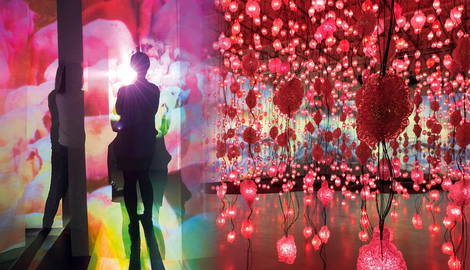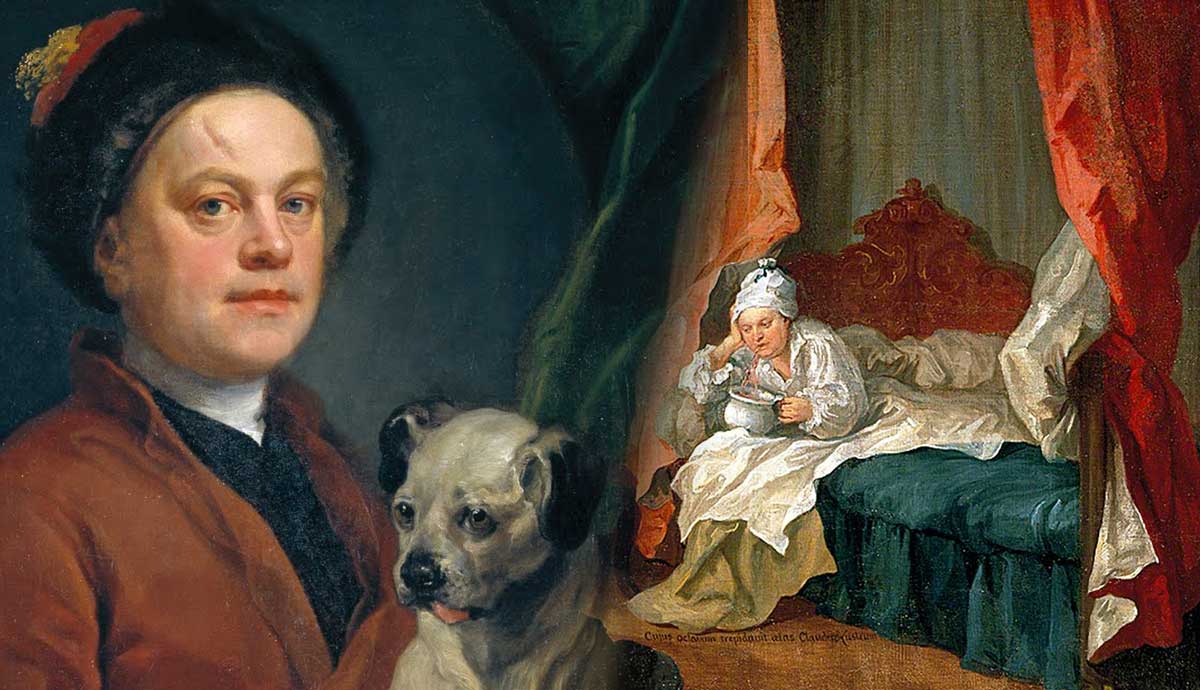
Lying in bed while simultaneously watching beautiful video art in a museum sounds impossible, but Pipilotti Rist made that happen. Born in Switzerland, Rist studied illustration and photography in Vienna and video art Basel. Known for her colorful palette, she became one of the most famous contemporary artists in video and installation art. In her work, Rist often explores the human body, womanhood, and nature. She is known for creating an unusual setting in which her pieces are shown. When seeing Pipilotti’s multimedia installations the viewer is invited to walk around, lie down, talk, sleep, and interact with the work. Here, we look at the art installations of Pipilotti Rist and explore her dreamy world.
Pour Your Body Out (7354 Cubic Meters): Pipilotti Rist Takes Over MoMA

Pour Your Body Out (7354 Cubic Meters) is a work of installation art created for the Museum of Modern Art in New York in 2008. MoMA invited Rist to create this site-specific artwork and the artist decided to use the whole museum for her multimedia installation. The number in the title of the exhibition (7354 Cubic Meters) refers to the volume of the museum. The exhibition was organized by the famous art curator Klaus Biesenbach.
The installation consisted of video, sounds, and objects – all combined to give the viewer an immersive experience of Pipilotti’s universe. In this piece, Rist focused on the human body. She shows the body in her videos by zooming-in, exploring it, and looking at it with an innovative approach. Pipilotti Rist sees the human body almost like a scientific researcher. The video also consists of images of landscapes, flowers, and liquids. For Pipilotti Rist, a museum is a place where people should enjoy themselves, where they should talk, and get to know one another. The audience in MoMA was able to look at the videos while lying down or sitting on a circular sofa in the atrium of the museum.

In a way, Rist also feminized the space of the whole museum by using colors like pink which are usually connected to femininity. Rist also showed us the female gaze at the human body and the world around us. The viewers were invited to do whatever they wanted and move freely through this art installation. The introductory text even noted that “Rolling around and singing is also allowed!”
Cape Cod Chandelier

Massachusetts Chandelier or Cape Cod Chandelier is an art installation created in 2011. This quirky piece looks like something from the Alice in Wonderland universe. Pipilotti’s chandelier consists of clean white underwear onto which videos are projected. The white of the hanging underwear serves as the canvas for the colorful projections. Themes related to the human body and sexuality are central to Pipilotti’s work. For Rist, hips represent a very complex part of the body that she wanted to acknowledge in this piece. She has said that “This part of the body is very sacred, the site of our entrance into the world, the centre of sexual pleasure and the location of the exits of the body’s garbage.”
For her exhibition at the Hayward Gallery in London, Rist created an art installation in the street using around 300 white underpants. The underwear was hung on wires outside the gallery so that at night this art installation functioned as a decorative street light as well.
Ever Is Over All

Ever is Over All is a video art installation Pipilotti Rist made in 1997 and presented at the 47th Venice Biennale. The installation functions as a video diptych where two projections are being cast on two connecting walls in the gallery. On one side, we see a video of a woman dressed in a blue dress and red shoes, looking a bit like Dorothy from the movie The Wizard of Oz. We see her carrying a stick that looks like a flower but is actually her weapon of choice. The woman uses this flower to break windows of parked cars while she happily walks down the street in slow motion.
In a way, Pipilotti Rist smashes the patriarchy in this video. A woman police officer approaches her but only to smile and nod. This interaction and the uplifting mood of the video while we watch something being destroyed points at the surreal elements of the video. You might have seen a similar scene in Beyonce’s music video for the song Hold up which must have been inspired by the work of Pipilotti Rist. The other side of the diptych of this feminist artwork shows colorful video images of nature and flowers.
Unusual Placement Of Video In Pipilotti Rist’s Installation Art

Pipilotti Rist explores a lot of different ways in which video can be used and placed in installation art. Her way of showing video art is almost always unconventional. In a work from 1994 called Yogurt on Skin – Velvet on TV, Rist placed tiny screens on the insides of women’s purses and seashells. Only when the viewer leans in and looks inside these objects is he able to see Rist’s videos.
Another one of Rist’s works focusing on body and garments is her 1993 piece called Digesting Impressions. For this piece, Rist put a circular monitor inside a yellow swimsuit at the place where the hips should be. The swimsuit hangs from the ceiling while being stretched out by the weight of the round screen inside of it. The video played inside the swimsuit shows images of human intestines filmed by an endoscopic camera. So, the viewer really gets to see what’s on the inside of the human body beneath all the clothes.
For her 2011 piece named Administrating Eternity, the artist used curtains as canvases for her video projections. The transparent curtains are layered one behind the other so that the video goes through each one and creates an abstract moving image. The visitors can walk between the curtains and cast their own shadows to make them a part of the work.

In her 2016 installation art piece called 4th Floor to Mildness, Rist placed 18 second-hand beds inside a gallery where visitors could lie down and watch the videos playing above their heads. Two large monitors hung from the ceiling and showed videos of the underwater world of the Old Rhine. So, while watching the video the viewer takes the position of a river plant. The fabric placed on the beds was made out of recycled pet bottles. In this work and many others, Pipilotti aims to explore the ways in which our perception of art changes if we feel relaxed and at ease. Another piece of installation art where Rist used a bed is Do Not Abandon Me Again, where moving images of outer space and stars are projected onto the bedsheet. The viewer is, again, invited to lie down should they care to do so.
Pixel Forest

Since videos are of great importance in Rist’s installation art, it’s not a surprise that she dedicated one whole work to pixels alone. Pixel Forest Mutterplatte is Rist’s art installation created in 2016. This piece was created in collaboration with light designer Kaori Kuwabara. The work consists of 3000 LED lights hanging from the ceiling representing pixels of light. The lights often change color and the viewer is invited to walk through them. Rist has said that the LED lights are supposed to resemble oxygen bubbles from seagrass. The work explores the influence of many different lights to which we are exposed, including the sunlight and the light coming from the screens in front of us. Rist described the installation as “literally taking the pieces of the screen and hanging it in a room in a very rough, raw resolution.”. She has also noted that the work was a “humorous reaction to Virtual Reality.”
Public Art By Pipilotti Rist

Pipilotti Rist also creates site-specific art outside of the museums and galleries.
The artist even exhibited one of her videos in Times Square. This feminist work called Open My Glade (Flatten) was commissioned by the Public Art Fund in 2000. In the video we see Pipilotti smearing the makeup off her face by touching the glass in front of her. Parts of her face start looking distorted when pressed upon the glass surface. It almost seems like the artist’s face is hitting the camera and trying to come out of the video. The video was probably the only screen in Times Square not used for commercial purposes. But, Pipilotti wasn’t selling anything, she was just there. The work was exhibited again in Times Square in 2017.
Open My Glade (Flatten) is not the only work of Pipilotti Rist created for a public space. In 2016 she designed a tram in Geneva for a public art project art&tram which aimed to connect art to urban living. Pipilotti’s tram named Monochrome Rose was all colored in pink. When you entered the vehicle, you’d be in for a ride in the pink dreamworld the artist created. Rist wanted people to take a meditative break by riding her pink tram.

Rist also helped design a restaurant! In 2011, the artist was invited to create a video installation for the top-floor bar at the Sofitel hotel in Vienna. For this project, she collaborated with the French architect Jean Nouvel. Rist created a colorful design for the ceiling of the restaurant with small video panels attached to it. Therefore, when you looked at the ceiling, a part of it would appear to be moving.










